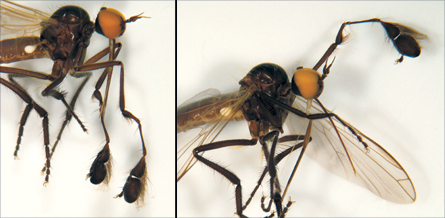Unlike the guy with two left feet, males of a new species of dance fly from Japan’s Mt. Fuji often grow feet that don’t match at all.

Dance flies are named for their erratic flight moves in mating swarms. Males of the new dance fly species can grow asymmetric front legs, one an unsurprising slim fly leg and the other ornamented with what looks like a little tufted balloon, says Christophe Daugeron of the French national research agency CNRS and the National Museum of Natural History in Paris. He and his colleagues give the fly an official scientific name, Empis jaschhoforum, in a paper released online the week of September 20 in Biology Letters.
Comparing the new fly’s ornaments to balloons isn’t unreasonable, since some of the hundreds of known dance fly species woo potential mates with little balloons of silk secreted from glands in their feet, says Adrian Plant, a coauthor of the paper and curator of the fly collection at the National Museum of Wales in Cardiff. Depending on the species, flies present bits of prey in balloons or sometimes just pretty, empty balloons. Sometimes moderately flashy flies win the most mates, suggesting that a lot of bling attracts attention from a distance but interferes with flying up close.
In Empis jaschhoforum, researchers have seen all possible leg permutations: ornaments only on the left, only on the right, on both legs or neither. That mix in the population might come from evolutionary tradeoffs between finery and practicality, the researchers suggest.
Daugeron says that as far as he can tell, the flies don’t seem to be infected with anything that would cause such variation. He didn’t see signs of nematodes, for example, which are known to create mosaics of male and female cells within the same individual. Asymmetric flies’ sex organs look normal, so he hypothesizes that real males can have either slender or balloon legs.
Originally collected in 1999 between 1,600 and 2,000 meters up Mt. Fuji, the 130 known specimens of the new fly show distinctive traits, such as some yellow hairs on the thorax, that make them a new species even without the leg anomalies, the researchers say. But of the 33 males collected, 14 had one fancy leg and one male had two. The other males and all the females grew plain, slender legs.
Without watching the flies in mating swarms, “it would be dangerous to speculate excessively about the factors involved in this trade-off,” Plant says. He does note that plenty of entertaining scenarios could fit what’s known so far about asymmetric males: “Somewhere on the slopes of Mt Fuji there might be swarms of very confused Empis jaschhoforum flying in tight circles lamenting their handicap; or worse still, with a corkscrew flight obligatory for successful mating.”





